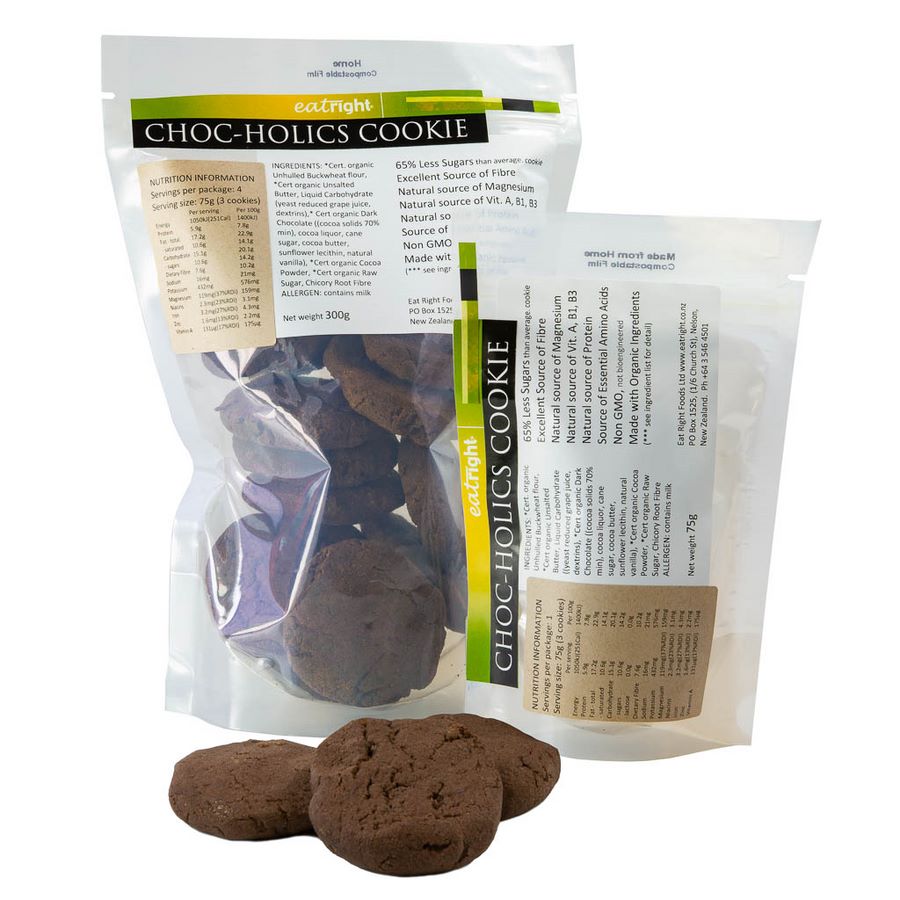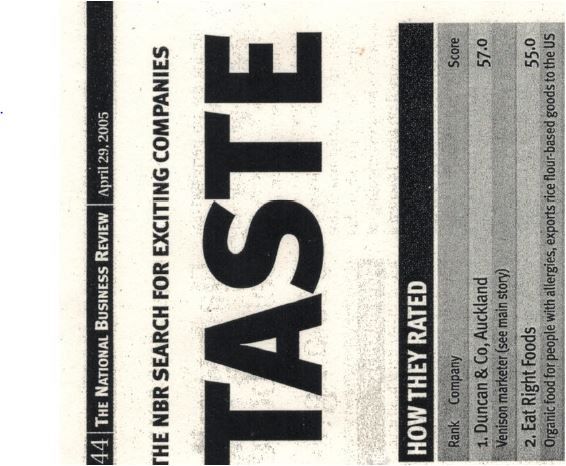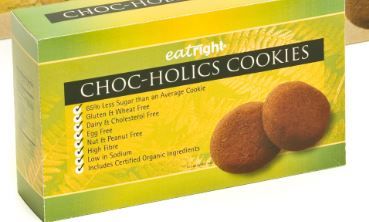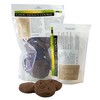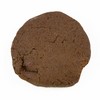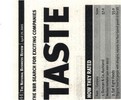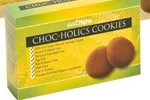EATRIGHT® Choc-Holic *MORE BENEFITS IN EVERY BITE* Cookies
‘Better choice’ EATRIGHT® Choc-Holic Cookies with 'consistently good' health benefits. Food matrix, not isolated, sources of seed-not-wheat essential vitamins, minerals, amino acids and beneficial dietary fiber with synthesis in the gut not the lab. Contain pleasure by-products with significant traces of yumminess [††].
Ingredients: *cert. Organic stoneground unhulled brank seed grist (Fagopyrum esculentum Moench) [fiber, high molecule weight (LC)], cert. Kosher and *cert. Organic unsalted butter (milk) (good source of vitamin D (5.2mcg/100g (vitamin D3 or cholecalciferol), vitamin B12 (0.68mcg/100g cobalamin) and nervoinc acid (0.1mg/100g)), cert. Kosher liquid carbohydrate (yeast reduced grape juice [3], vegetable dextrins), *cert. Organic dark chocolate (7%) ((cocoa solids 70% min), cocoa liquor, cane sugar, cocoa butter (theobroma oil), sunflower lecithin, natural vanilla), *cert. Organic cacao (Theobroma cacao L.) powder [4], *cert. Organic non-centrifugal sugar (NCS) (Saccharum officinarum L.), *cert. Organic chicory root (a less refined source inulin, aesculin) (Cichorium intybus L.) [5][6].
Contains: milk. Latest update: 30/1/24
Nutrition Information per 75g (2.6oz) serving (3 x 25g cookies per day)
Macro nutrition information: Energy 1040kJ (248Cal)(12%DI), Protein (5.9g)(12%DI), Protein-gluten (0g), Fat-total (17.2g)(25%DI), Fat-sat (10.6g)(44%DI), CHO-total (14.2g)(5%DI), CHO-total sugars (9.8g)(11%DI), CHO-lactose (0.1g), CHO-galactose (0.0g, traces maybe present), Dietary Fiber/Fibre (7.6g)(25%DI), Sodium (Na) (16mg)(1%DI)
Micro nutrition information: [in %DI descending order] preformed Vitamin K** (179mcg)(149%ESADDI), Magnesium (Mg) (119mg)(37%RDI), Iron (Fe) (3.2mg)(27%RDI), Niacin (vitamin B3) (2.3mg)(23%RDI), preformed Vitamin A (131mcg)(17%RDI), Manganese (Mn) (832mcg)(16%ESADDI), Thiamin (vitamin B1) (0.2mg)(14%RDI), Zinc (Zn) (1.6mg)(13%RDI), Potassium (K) (432mg)(9%RDI), Vitamin B12 (0.11ug)(5%RDI), Essential Amino Acids (1702mg; including Arginine+Threonine 240mg; Tryptophan 75mg; Methionine 65mg), >50mg (choline-&-betaine-&-folate)
Abbreviations: The % Daily Intake (%DI), Recommended or Reference Daily Intakes (%RDI), Estimated Safe and Adequate Daily Dietary Intake (%ESADDI) tells you how much a nutrient, in a serving of food, contributes to a daily diet. An average adult diet of 8,700KJ or 2,000 calories a day is used for general nutrition advice. ** Vitamin K (K1 and K2(MK4-MK13)) [7][8] (not on-pack/container) is calculated (eg what [the cows] eat matters; grass-fed has positive effect on values) and USDA data.
Shelf life: 18 weeks or more. Can be chilled or frozen indefinitely (at 0ºC (32ºF) or less)
Country of Origin: Made in NEW ZEALAND. >70% grown from NEW ZEALAND's bio-economy ingredients. <30% "originating in" the USA or "[] region" (ie Peru and Paraguay)
Food SAFETY Verification: Certificate Number 2699 (an International Accreditation NEW ZEALAND (IANZ) third-party inspection body audit, pursuant to the Food Act 2014) issued to Eat Right Foods Ltd at MPI's highest risk level, for the manufacture, processing, exporting, packing, holding and distribution of food products. And the independent audit company is ISO 17020 accredited
Additional Audited Compliance: Australian NEW ZEALAND Food Standards Act 1991 (FSANZ Act) and Code 2002; CAFTA Model Recall Procedure: Food Australia, 45(7), 313-316 1993; Codex Alimentarius Commission: Hazard Analysis Critical Control Point (HACCP) System & Guidelines Annex to CAC/RCP 1-1969, Revised 2022; Food Regulations 2015 (LI 2015/310), version July 2023 and Fair Trading Amendment Act 2021
Availability: An EATRIGHT® Online Shop Only Product
Address: PO Box 1525 [Level 1, 6 Church St], Nelson 7040, NEW ZEALAND
Packaging: Tamper-proof double seal, easy open, resealable 'zip'. Home compostable degradation enjoys a companion mix of micro-organisms, moisture, heat and oxygen
Labels: Re-jacket of an EATRIGHT® "best seller" after a re:injection, re:investment to enable important product virtue diversification. NB. Not a "white-label" or "private-label" product. 'Open dating' (best if used by, sell by) label is included.
PS. “Contains at least 4% of naturally conserved cocoa flavanols”
Cocoa, dry powder, unsweetened (NDC: 19165 (ref: 8, 105); comparable ingred.)
USDA Special Interest Database: Flavonoid Content of Selected Foods (rel. 3.3, '18).
* Flavan-3-ols: (-)-Epicatechin 196.43mg/100g, * (+)-Catechin 64.82mg/100g (rank=5th).
* Flavonols: Quercetin 10mg/100g
Database for the Proanthocyanidin Content of Selected Foods (release 2.1, 2018).
* Dimmers: 277.13mg/100g, trimmers: 195.73mg/100g, 4-6mers: 419.05mg/100g, 7-10mers: 925.18mg/100g, polymers: 2435.11mg/100g
FoodData Central (2006): Choline, total: 12mg/100g; theobromine: 2060mg/100g
Ref 8: Flavanol and flavonol contents of cocoa powder products: Influence of the manufacturing process by Andres-Laceuva, Monogas, Khan et al (pub. 2008). Cocoa powder. Catechin, Epicatechin, Quercetin. With NO choline bitartrate (E322) additive.
Ref: 105: Procyanidin and catechin contents and antioxidant capacity of cocoa and chocolate products by Gu, L., House, S. E., Wu, X., Ou, B., and Prior, R. (pub. 2006). Cocoa, Chocolate products (milk, dark, baking, unsweetened, natural, Dutched). Catechin, Epicatechin, Procyanidins (mono, 2-3-mers, 4-6-mers, 7-10-mers, polymers), ORAC (‘oxygen radical absorption capacity’ database).
Cacao. phytochem: OPC (oligomeric procyanidin) 80,000ppm; phenolics: 130,000ppm (Duke Database epub.'16)
[†] Googled "Low sugar biscuits" (Feb’08). See also 'unusually deep...[BIG] moats' example of 'ABC.xyz' domain registrant org, IP location and (2014-03-20) created date c/- dkt 21 MTD "Inc" and subsequent report on BigTech "market power" (1st rel. Oct'20, pub. Jul'22). And interesting Oxford Dictionary abbreviation: "A.B.C., the alphabet; alphabetical train-table; Aerated Bread Company's Shop".
[††] “Huge market for these – tastes great considering what they are…considering all [its] health benefits”. Report for Eat Right Foods, May '07. RFP No. 51, Feb '15.
Inconvenient data: FOOTNOTE: “Whole Foods’ website in 2010—there is a reference to Eat Right America in the context of educational materials, but no mention of Whole Foods’ use of the mark on food products in stores. And there is a REMARKABLE [emphasis added] absence of any photos on Whole Foods’ website showing uses of the mark EATRIGHT AMERICA on food products” (nb. Unpublished draft "Brief of Appellant" 9th Cir Appeal 15-35524 c/- published "Brief of Appellant" p28 “Whole Food’s website in January 2010…"). Where remarkable (a. worth notice, exceptional, striking (ref: OX Dict)) and strike “material in declaration of Albert Percival (ECF No 32)” (ref: 2:13-cv-02741 dkt 37)
Product Details
- Biological activity: Anti-CVI (chronic venous insufficiency), PhytochemID: Rutin (270mg/day/man). Rutin source: Buckwheat seed (87ppm-511ppm). Biological Activity: Preservative, PhytochemID: Formic-acid ((ADI=3mg/kg) Cacoa, Grape) and Ferulic-acid (Grape) USDA's Phytochemical and Ethnobotanical Databases
- Ethnobotany use buckwheat: glaucoma; Syndrome: antiglaucomic (rutin 60mg/day et al); Activities (buckwheat): anticataract: ascorbic acid (350mg/day), methionine, niacin, quercetin, quercitrin, riboflavin (15mg/day), rutin, selenium 400ug/day), thiamine, USDA's Phytochemical and Ethnobotanical ['AIL'] Databases ['glaucoma' hard[er]-to-find']
- Ethnobotany use buckwheat: gravel (disease with) aggrevations of urinary crystals. Chinese medinal herbs by Li Shih-chen, Georgetown Press, San Francisco 1973
- Hemostat: chicory root (cellulose 50,000ppm), cacao (cellulose + citric acid = 97,500ppm) [(+)-Catechin], buckwheat (quercetin + quercitrin + rutin (87-511ppm)), grape (quercitrin). USDA's Phytochemical and Ethnobotanical Databases (epub. '16)
- Theobroma CACAO (Sterculiacae). Cacao (typically used to describe the plant) source of ChemID: 1-butyric-acid. Cocoa (used to describe processed beans-seeds) source of ChemID: Amyl-butyrate. Activities: Ataxigenic, FLavor FEMA 70-800, Sedatiative. Both 1-butyric-acid and Amyl-butyrate are non-ubiquitous. Ref: Duke, James A. 1992 online database
- Activities (Cacao) — Parasiticide (f; CRC; DAD); Indications (Cacao) — Parasite (f; CRC; DAD), Worm (f; CRC). Duke, J.A. and duCellier, J.L., Handbook of Alternative Cash Crops, CRC Press, Boca Raton 1993. (DAD)
- Activities (Grape) — Antioxidant; (1;APA; FNF; PH2; X10820088); Collagen Protective (1; APA), Radioprotective (1; X10820088) Ref: Dr Duke, Handbook of Medicinal Herbs (epub. '02).
- Ethnobotany use: Intellect. Grape (Shih-chen, Li. 1973. Chinese medinal [medicinal] herbs. Georgetown Press) Artificial: Produced by art & not by nature...in imitation of the natural (Pocket Oxford Dictionary, corrections '52)
- Cocoa (Cacao) source of amyl-butyrate. Criollo variety used [nb. forastero accounts for more than 90% of the world's usage] Leung’s encyclopedia of common natural ingredients used in food, drugs, and cosmetics by Ikhlas A. Khan and Ehab A. Abourashed (3rd ed. Pub. 2010).
- Cocoa source of amines and alkaloids, including theobromine (0.5–2.7%)^, caffeine (ca. 0.25% in cocoa)^^, tyramine (between 0.1 and 2.8μg/g), dopamine, salsolinol (40 ± 4μg/g), trigonelline, nicotinic acid, and free amino acids'. Leung, A. Y. Encyclopedia of common natural ingredients used in food, drugs, and cosmetics (pub. 1980)
- Bio demulcent [relieving inflammation and irritation] activity: chicory, grape and cacao. USDA's Phytochemical and Ethnobotanical Databases (epub. '16)
- PhytochemID: Catechin (Ubiquitous. NO). Source: vanilla. 43 bio-activities, including Antihistaminic (1,000mg 5x/day/man), Antiviral [especially against the Lupus Simplex Virus (Prog Clin Biol Res 86;213:521-36)] PhytochemID: Vanillin (Ubiquitous. NO). Source: vanilla. Antiyeast dosage 8-30mM, Candidicide dosage 8-20mM (ref: USDA Phytochemical & Ethnobotanical Databases)
- ^Theobromine: Antiasthmatic 10 mg/kg/orl/man; Diuretic 300–600 mg/man/day; Fetotoxic 100 mg/kg; Teratogenic 100 mg/kg and others. Medicinal Spices by Dr James Duke et al (pub. 2003)
- ^^Caffine: CNS (central nervous system stimulant). CAS (chemical abstract service) # 58,082. Cacoa source of caffine 500-12,900ppm. Dr Duke's Phytochemical and Ethnobotanical Databases.
- * COX-2 Inhibitor ([+]-catechin), ‘might be viewed by enthusiasts as another herbal miracle aspirin’ (COX, Newmark and Schulick, 2000). Catechins...specifically recommended for colitis (Brown et al., '97). COX-2 Inhibitor: nonsteroidal anti-inflammatory drug (NSAID)
- Sugarcane source of PhytochemID: Policosinol. PubMedID: 23018482. …Foods versus the Synthetic Silver Bullet by James Duke, PhD see also: Rutin: PubmedID 18217700. Inulin: PubmedID 12571376
- Biological activity: memorigenic. Phytochem: choline, chromium et al USDA's Phytochemical and Ethnobotanical Databases (epub. '16)
- Butter (L=lipid and D=dairy) source of vitamin B12 (34%RDI). 'Deficiencies may result in pernicious anaemia and compromised neurodevelopment and brain function'. FAO. 2023. Contribution of terrestrial animal source food to healthy diets for improved nutrition and health outcomes...state of knowledge and gaps.
- “Taste of Success” p44 “The [New Zealand] National Business Review “second most exciting food and beverage wholesaler” (2005). Choc-holics Cookie introduced Jan04, update Aug05
- Owners obsession in problem solving with significant 'toiling in mediocrity'
- [1] Brank as a Functional Food and Its Effects on Health
by Juan Antonio Giménez-Bastida and Henryk Zieliński (pub. Sep'15)
- [2] Rutin has therapeutic effect on septic arthritis caused by Candida albicans
by YongmoonHan (pub. Feb’09). Rutin phytochem activity: Antinephritic [anti-inflammation of kidneys]. DrDukeData
- [3] Antioxidant activity and radioprotective effects against chromosomal damage induced in vivo by X-rays of flavan-3-ols (Procyanidins) from grape seeds: comparative study versus other phenolic and organic compounds. Castillo et al (pub. May'00)
Activities (grape): Radioprotective (1; X10820088); Antioxidant; (1;APA; FNF; PH2; X10820088)
- [3] [Clinical and capillaroscopic evaluation of chronic uncomplicated venous insufficiency with procyanidins extracted from vitis vinifera] by Costantini et al (pub. Feb’ ’99)
Indications (grape): CVI (1; PH2; X10356940). Handbook of Medicinal Herbs. Dr Duke (pub. '02)
- [4] Theobroma cacao L. is a natural source of medicines. 936 to 13,000ppm theobromine. Activities include diuretic 300-600 mg/man/day. Martindale's 28th
USDA, Agricultural Research, National Plant Germplasm. 2022 (GRIN Taxonomy), Maryland, USA. Crossref to '92-'16 Dr. Duke's Phytochemical Ethnobotanical Databases [archived Feb’16] cacao is a catalase [CAT] source
- [5] A combination of prebiotic short- and long-chain inulin-type fructans enhances CALCIUM absorption and bone mineralization in young adolescents
by Steven A Abrams, Ian J Griffin, Keli M Hawthorne, Lily Liang, Sheila K Gunn, Gretchen Darlington, Kenneth J Ellis (pub. Aug'05)
- [6] Reduction of vitamin K2 concentrations in human liver associated with the use of broad spectrum antimicrobials. See also A-Z Guide to Drug-Herb-Vitamin Interactions Edited by Alan R. Gaby and the Healthnotes Medical Team (2nd Ed. Pub. 2006) p315
by Conly J, Stein K (pub. Dec 1994)
- [7] ID 2879-80: “Menaquinone-7 (MK-7, a form of vitamin K2)” “Bone health, Cardiovascular Health”
Article 13 health claims List of references received by EFSA Part 3 IDs 2001-3000 (pub. Apr’11)
- [8] Vitamin K per 100g: buckwheat flour 7ug, chocolate 9.7ug, cocoa powder 2.5ug
USDA FoodData Central
- Sweet Justice Ltd chocolate factory has decided to cease production of chocolate products from July 2024.
Communication sent to suppliers 22Mar24

